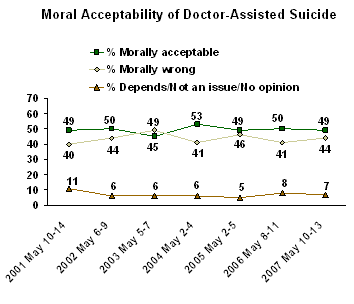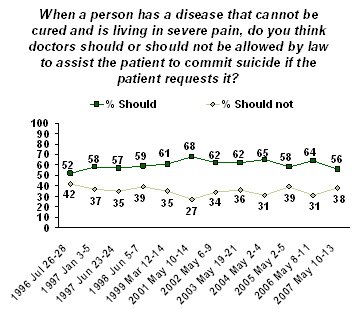GALLUP NEWS SERVICE
PRINCETON, NJ -- Jack Kevorkian, the Michigan doctor who assisted more than 130 terminally ill patients with ending their life, will be released from prison on parole this Friday. Gallup's annual Values and Beliefs poll finds Americans are generally divided about whether doctor-assisted suicide is morally acceptable or morally wrong. Even so, a majority of Americans believe doctors should be allowed to help a terminally ill patient commit "suicide" if the patient requests it. Most Americans also say doctors should be allowed by law to "end" a terminally ill patient's life by some painless means if the patient and family request it. Republicans are more likely than Democrats to oppose these right-to-die issues, as are frequent churchgoers compared with those who rarely or never attend church.
Moral Acceptability of Doctor-Assisted Suicide
According to the May 10-13, 2007 poll, 49% of Americans say doctor-assisted suicide is morally acceptable, while 44% say it is morally wrong. Americans have been closely divided about the moral acceptability of doctor-assisted suicide since this specific morality question was first asked in 2001. The percentage of Americans saying assisted suicide is morally acceptable has averaged 49%, with a low of 45% and a high of 53%.

Of the 16 issues tested in the poll for moral acceptability, doctor-assisted suicide ranks in the middle of the list, scoring similarly to gay and lesbian relations. Americans are most likely to say the death penalty, divorce, stem cell research, and gambling are morally acceptable, with at least 6 in 10 describing each of these issues is morally acceptable. Americans are least likely to view adultery, polygamy, human cloning, and suicide as acceptable.
Should Doctors Help Terminally Ill Patients End Their Life?
A majority of Americans in the poll support both euthanasia and doctor-assisted suicide.
Half of the respondents in the survey were asked about doctor-assisted suicide using the following wording:
"When a person has a disease that cannot be cured and is living in severe pain, do you think doctors should or should not be allowed by law to assist the patient to commit suicide if the patient requests it?"
The results show that 56% of Americans support this and 38% do not.
Gallup has asked a more general question regarding the acceptance of physicians assisting in ending suffering patients' lives since 1996 -- when the term "doctor-assisted suicide" started to come into use in the news coverage of Kevorkian. A majority have always supported doctor-assisted suicide, with a high point of 68% support in 2001. The current 56% level of support is on the low end for what Gallup has found.

The other half of the respondents in the survey were asked about euthanasia more generally:
"When a person has a disease that cannot be cured, do you think doctors should be allowed by law to end the patient's life by some painless means if the patient and his or her family request it?"
Support for euthanasia has always been higher than support for doctor-assisted suicide. In the current poll, 71% favor euthanasia, while 27% oppose it.
Over time, support for euthanasia has increased substantially. When this question was first asked in 1947 and again in 1950, only about one in three Americans said they supported euthanasia. Support reached the majority level in 1973, with 53% supporting it. Since 1990, support has been much higher, ranging from 65% to 75%.

Partisan Support for Doctor-Assisted Suicide
Democrats (including independents who lean toward the Democratic Party) are much more likely than Republicans (including Republican-leaning independents) to support euthanasia and doctor-assisted suicide.
|
Partisan Attitudes Toward Doctor-Assisted Suicide and Euthanasia
|
||
|
Republicans
|
Democrats
|
|
|
% |
% |
|
|
When a person has a disease that cannot be cured, do you think doctors should be allowed by law to end the patient's life by some painless means if the patient and his or her family request it? |
||
|
Yes |
64 |
77 |
|
No |
32 |
22 |
|
|
|
|
|
When a person has a disease that cannot be cured and is living in severe pain, do you think doctors should or should not be allowed by law to assist the patient to commit suicide if the patient requests it? |
||
|
Yes |
49 |
62 |
|
No |
45 |
32 |
|
|
|
|
|
Doctor-assisted suicide morally acceptable? |
||
|
Yes |
39 |
59 |
|
No |
54 |
36 |
Seventy-seven percent of Democrats say doctors should be allowed to end a terminally ill patient's life by some painless means if the patient and family request it. Among Republicans, 64% support this notion.
When it comes to doctors assisting a terminally ill patient to commit suicide, 62% of Democrats and only 49% of Republicans support this.
Fifty-nine percent of Democrats believe doctor-assisted suicide is morally acceptable. A similar percentage of Republicans, 54%, feel it is morally wrong.
Churchgoers' Views on Doctor-Assisted Suicide and Euthanasia
Fewer than half of Americans who attend church services every week support either doctor-assisted suicide or euthanasia, and only 23% of weekly churchgoers say doctor-assisted suicide is morally acceptable. Americans who attend church services less often are much more likely to support the right-to-die issues.
|
Religiosity and Doctor-Assisted Suicide and Euthanasia
|
|||
|
|
Attend
|
|
|
|
% |
% |
% |
|
|
When a person has a disease that cannot be cured, do you think doctors should be allowed by law to end the patient's life by some painless means if the patient and his or her family request it? |
|||
|
Yes |
47 |
70 |
84 |
|
No |
51 |
27 |
14 |
|
|
|
|
|
|
When a person has a disease that cannot be cured and is living in severe pain, do you think doctors should or should not be allowed by law to assist the patient to commit suicide if the patient requests it? |
|||
|
Yes |
35 |
52 |
73 |
|
No |
62 |
39 |
21 |
|
|
|
|
|
|
Doctor-assisted suicide morally acceptable? |
|||
|
Yes |
23 |
45 |
67 |
|
No |
71 |
48 |
24 |
Survey Methods
Results are based on telephone interviews with 1,003 national adults, aged 18 and older, conducted May 10-13, 2007. For results based on the total sample of national adults, one can say with 95% confidence that the maximum margin of sampling error is ±3 percentage points.
For results based on the 500 national adults in the Form A half-sample and 503 national adults in the Form B half-sample, the maximum margins of sampling error are ±5 percentage points.
In addition to sampling error, question wording and practical difficulties in conducting surveys can introduce error or bias into the findings of public opinion polls.
